*Institute for Manufacturing Technologies of Ceramic Components and Composites, University of Stuttgart
Introduction
Renewable raw materials have recently become a major topic of discussion because of the limited availability of fossil fuels. Questions about crop yields, the amount of acreage required and energy content are at the forefront here. As compared to fossil fuels, the combustion behavior of renewable raw materials is far more influenced by parameters such as climatic conditions, plant part processing, drying and storage – along with the associated moisture content – and is therefore subject to greater natural variation. Figure 1 shows a compilation of raw materials and those which can be classified as biomass and energy plants.
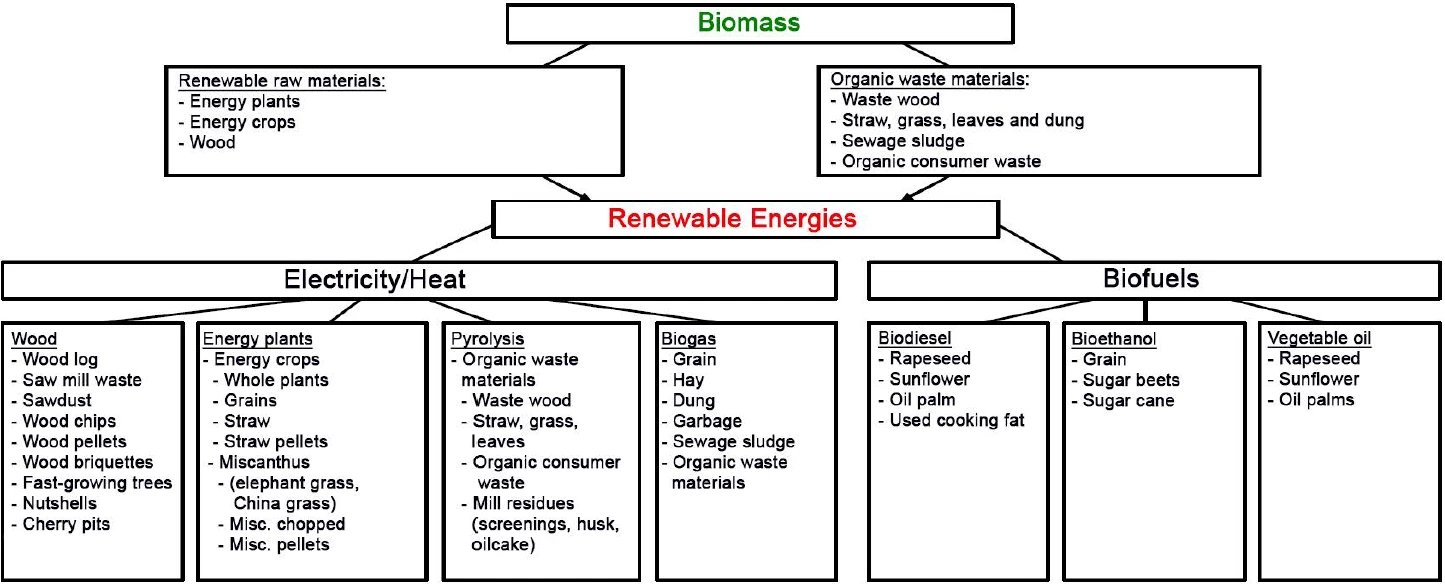
Energy Plants
If energy plants are to be used as an alternative for fossil fuels, procurement costs must be compared with crop yields. For example, 232 kg of barley is equivalent to 100 liters of heating oil in heating value [1] and is 41 Euro cheaper in cost based on the market prices of September 2013. Assuming an annual consumption of 3,000 liters for heating a detached house in Germany, the savings would be 1,200 Euro per year. Since agricultural plants, like various types of grains, only need to be used for energy production if they are inedible or of minor quality and therfore unfit for human consumption, alternative energy plants are being intensively examined.
In view of the rising prices for crude oil, wood pellets and other, energy plants already offer a cost-effective alternative. Mean prices and heating values for crop straw, wood pellets and heating oil are compared in table 1 [2].
Table 1: Heating values and costs of different energy carriers
Price | Heating value | Cost / 1000 MJ | |
|---|---|---|---|
| Heating oil | 850 €/t | 35 MJ/l | 23.40 € |
| Wood pellets | 220 €/t | 19 MJ/kg | 11.57 € |
| Crop straw | 110 €/t | 16 MJ/kg | 6.87 € |
As can be seen from the table, the lower heating value for crop straw is offset by its considerably lower acquisition costs making it more economical than heating oil. Hence, agricultural waste such as straw from cereal production deserves a closer look as an alternative energy source along with other energy plants that grow readily on almost all types of soil. Chinese silver-grass (miscanthus sinensis) and miscanthus giganteus also exhibit comparatively high calorific values and low Ash ContentThe ash is a measure of the mineral oxide content on a weight basis. Thermogravimetric analysis (TGA) in an oxidative atmosphere is a well-proven method to determine the inorganic residue, commonly referred to ash, in organic materials such as polymers, rubbers, etc. Therefore, the TGA measurement will identify if a material is filled and calculates the total filler content.ash content and are therefore of interest for further investigation. Although miscanthus must be especially cultivated for energy use, rapeseed straw is available as byproduct of grain production. Acreage limitations must therefore be considered in weighing the benefits of the two energy sources.
Thermogravimetry
The method of thermogravimetry (TG) is particularly suited for the investigation of combustion processes. It enables a rapid evaluation of the Thermal StabilityA material is thermally stable if it does not decompose under the influence of temperature. One way to determine the thermal stability of a substance is to use a TGA (thermogravimetric analyzer). thermal stability of mainly solid fuels. The amount of combustible material (mass loss) and remaining Ash ContentThe ash is a measure of the mineral oxide content on a weight basis. Thermogravimetric analysis (TGA) in an oxidative atmosphere is a well-proven method to determine the inorganic residue, commonly referred to ash, in organic materials such as polymers, rubbers, etc. Therefore, the TGA measurement will identify if a material is filled and calculates the total filler content.ash content (residue) are easily quantified. The combustion temperature and reaction rate analyzed by means of the NETZSCH Thermokinetics software yields important kinetic information about the combustion behavior of the material.
Both the mass loss during the combustion reaction and the non-flammable mineral Ash ContentThe ash is a measure of the mineral oxide content on a weight basis. Thermogravimetric analysis (TGA) in an oxidative atmosphere is a well-proven method to determine the inorganic residue, commonly referred to ash, in organic materials such as polymers, rubbers, etc. Therefore, the TGA measurement will identify if a material is filled and calculates the total filler content.ash content can also be quantified. In contrast with other reactions, such as Decomposition reactionA decomposition reaction is a thermally induced reaction of a chemical compound forming solid and/or gaseous products. decomposition or the release of moisture or solvents, combustion is a solid-gas reaction. Parameters such as sample surface, concentration of oxygen in the purge gas and crucible geometry are therefore crucially important.
These important parameters were optimized in experiments using the NETZSCH STA 409 C for combustion of energy plants.
Combustion Behavior
This application note describes the results of an investigation of the combustion behavior of plant-based straw (miscanthus and repeseed) and pellets made therefrom. The substances that were investigated are depicted in figures 2 and 3.


The combustion behavior of the materials was investigated with a NETZSCH STA 409 C. A DTA-TGA sample holder with open alumina crucibles was employed; the purge gas was synthetic air with a flow rate of 80 ml/min. When employing a heating rate of 20 K/min, the combustion reactions were complete by 600°C (figures 4 and 5).
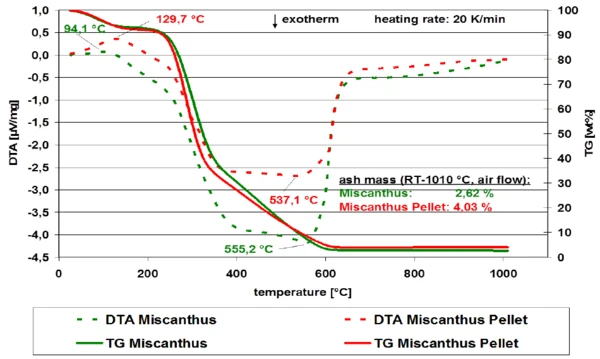

The DTA method yields information on the amount of heat generated and the rate of heat generation for the ExothermicA sample transition or a reaction is exothermic if heat is generated.exothermal combustion reaction. It should be noted that the nonpelletized samples showed a higher heat of reaction (larger DTA signal) even though the mass loss profile was similar. The higher surface area of the loose material promotes a more efficient combustion process. Moreover, the rapeseed straw samples exhibited combustion behavior similar to that of miscanthus samples. The residual mass (Ash ContentThe ash is a measure of the mineral oxide content on a weight basis. Thermogravimetric analysis (TGA) in an oxidative atmosphere is a well-proven method to determine the inorganic residue, commonly referred to ash, in organic materials such as polymers, rubbers, etc. Therefore, the TGA measurement will identify if a material is filled and calculates the total filler content.ash content) corresponds to the inert mineral components of the energy plants.
Determination of Porosity and Density
By means of mercury porosimetry (Porotec Pascal 140/440), the porosity and DensityThe mass density is defined as the ratio between mass and volume. density of the samples were determined. The results are summarized in table 1. Figures 6 and 7 illustrate the significant differences between the two materials and their processed products (pellets) with regard to porosity and their relative or specific DensityThe mass density is defined as the ratio between mass and volume. density. The rapeseed straw sample is characterized by a lower DensityThe mass density is defined as the ratio between mass and volume. density and a considerably larger pore volume than the miscanthus sample (table 1). This obviously favors the combustion behavior since the non-pelletized rapeseed straw sample showed a significantly higher rate of combustion at a considerably lower temperature than the rapeseed straw pellet sample (figure 5).
Table 2: Comparison of the analytical data of the four biomass samples
| Properties | Miscanthus | Miscanthus pellets | Rapeseed straw | Rapeseed pellets |
|---|---|---|---|---|
| Total porosity [vol%] | 67.01 | 9.82 | 64.15 | 15.96 |
| Commulated pore volume [m²/g] | 1366.0 | 70.0 | 2412.9 | 128.4 |
| Specific sample surface [mm²/g] | 16.87 | 6.64 | 3.64 | 7.75 |
| Average pore radius [μm] | 6.545 | 0.393 | 1.019 | 0.817 |
| DensityThe mass density is defined as the ratio between mass and volume. Density1 [kg/dm³] | 0.49 | 1.40 | 0.27 | 1.24 |
| Apparent DensityThe mass density is defined as the ratio between mass and volume. density2 [kg/dm3] | 1.49 | 1.56 | 0.74 | 1.48 |
1DensityThe mass density is defined as the ratio between mass and volume. Density: DensityThe mass density is defined as the ratio between mass and volume. Density of the solid network (including pores and interparticular hollow space)
2Apparent DensityThe mass density is defined as the ratio between mass and volume. density: DensityThe mass density is defined as the ratio between mass and volume. Density of the material including closed and non-accessible pores
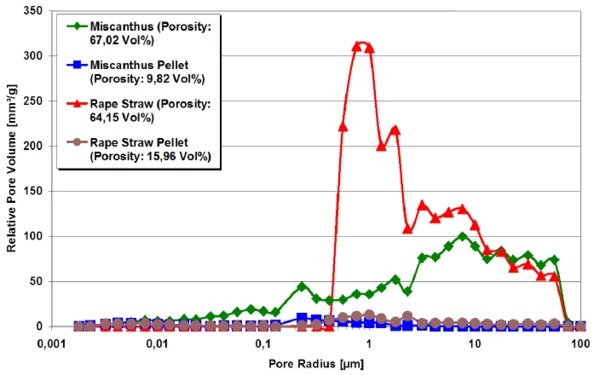
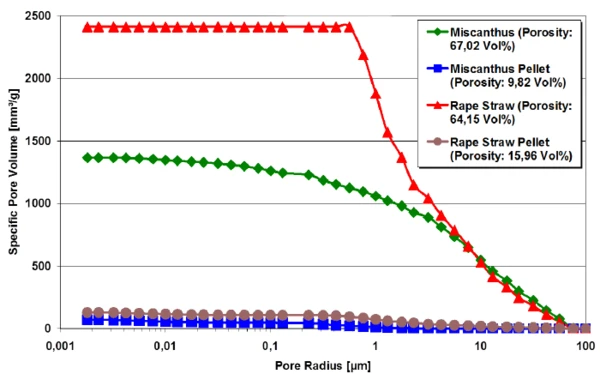
Gas Detection and Kinetic Analysis
FT-IR characterization of the evolved gases formed over the course of the thermogravimetric analysis revealed that the gases generated at the peak in the Decomposition reactionA decomposition reaction is a thermally induced reaction of a chemical compound forming solid and/or gaseous products. decomposition rate (at 515°C) consisted mainly of CO2. Boundary condition influences to the reaction rate can be avoided to a great extent if a crucible with a planar base and a sufficiently high gas flow rate (here 160 ml/min oxygen) are employed. This fulfills a crucial requirement for subjecting the data obtained to an in-depth kinetic analysis. Thermokinetic analysis of the thermogravimetric data from miscanthus pellet sample obtained at heating rates between 1 and 5 K/min. was carried out with the help of NETZSCH Thermokinetics software Two consecutive nth order reactions were found to offer the best fit to the experimental data, as shown in figure 9.
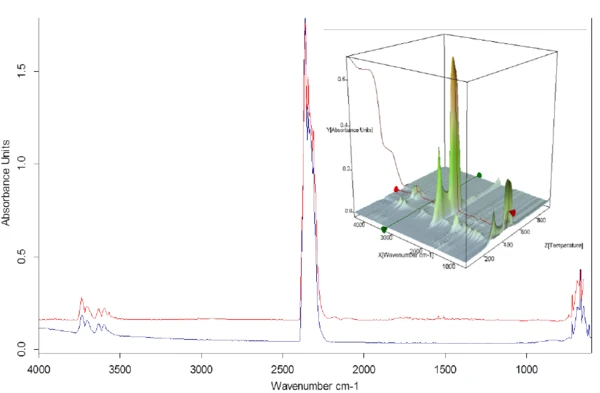
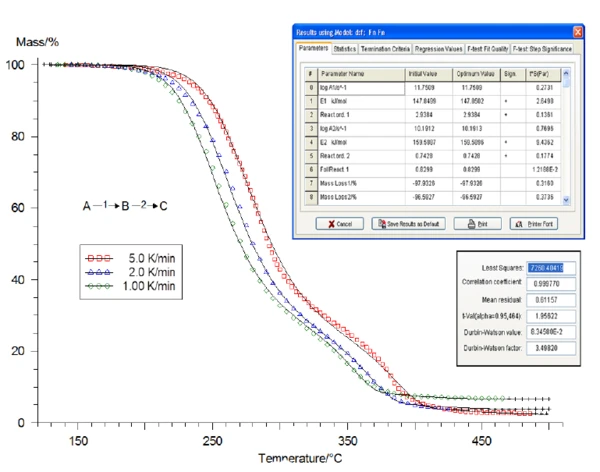
Conclusion
These thermogravimetric investigations showed that sample preparation and measurement conditions have a substantial influence on the results. Reliable comparisons between different energy plant samples regarding their combustion behavior can only be made when measurements are performed on plant samples with similar packing DensityThe mass density is defined as the ratio between mass and volume. density and geometry and under the same purge gas conditions (i.e., oxygen concentration and flow rate).
For comparative investigation of the combustion behavior of different energy plants, it could be determined that the measuring parameters such as sample geometry, sample quantity, oxygen concentration of the purge gas, amount of purge gas but also the size of the plant parts or packaging DensityThe mass density is defined as the ratio between mass and volume. density of the samples are of decisive importance. In order to minimize these outer influences, all measurement parameters of the STA 409 C were adjusted such that no measurable influences of these boundary conditions can affect the results. Only this way is it possible to realize comparative thermogravimetric analysis but also kinetic evaluation of the measurement data.
Although miscanthus is attractive as an energy source because of its high energy DensityThe mass density is defined as the ratio between mass and volume. density, the need for special cultivation of this crop lowers its potential value. Rapeseed, on the other hand, is a readily obtainable by-product of cereal production and also a good source of energy.